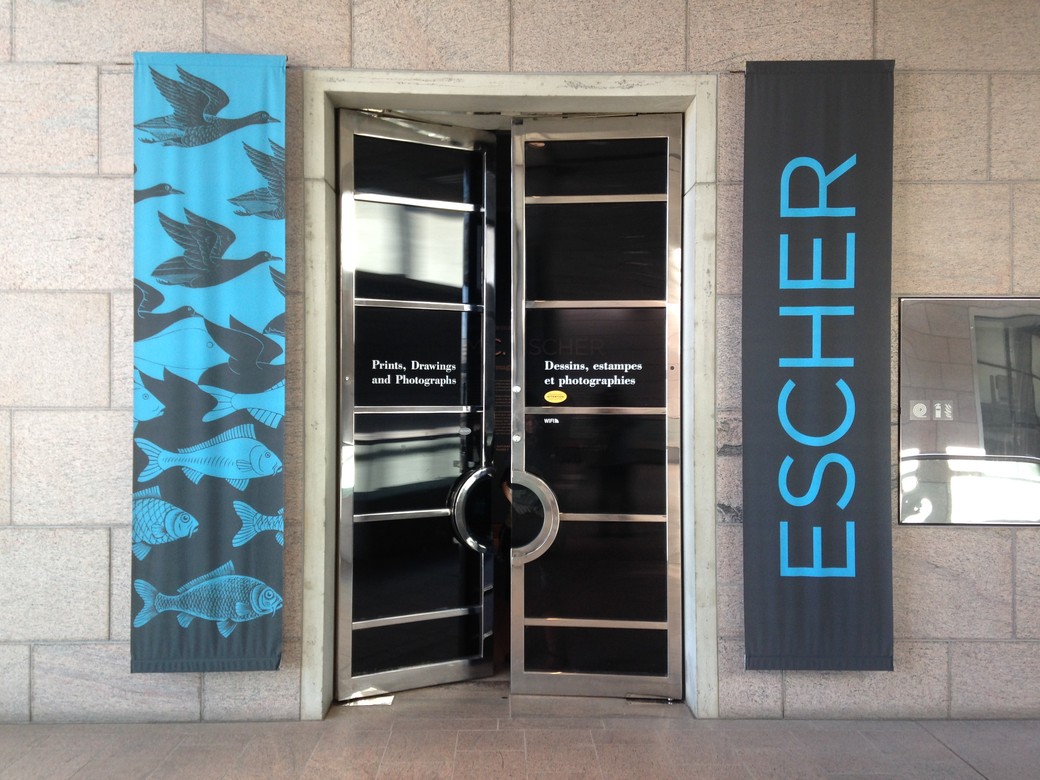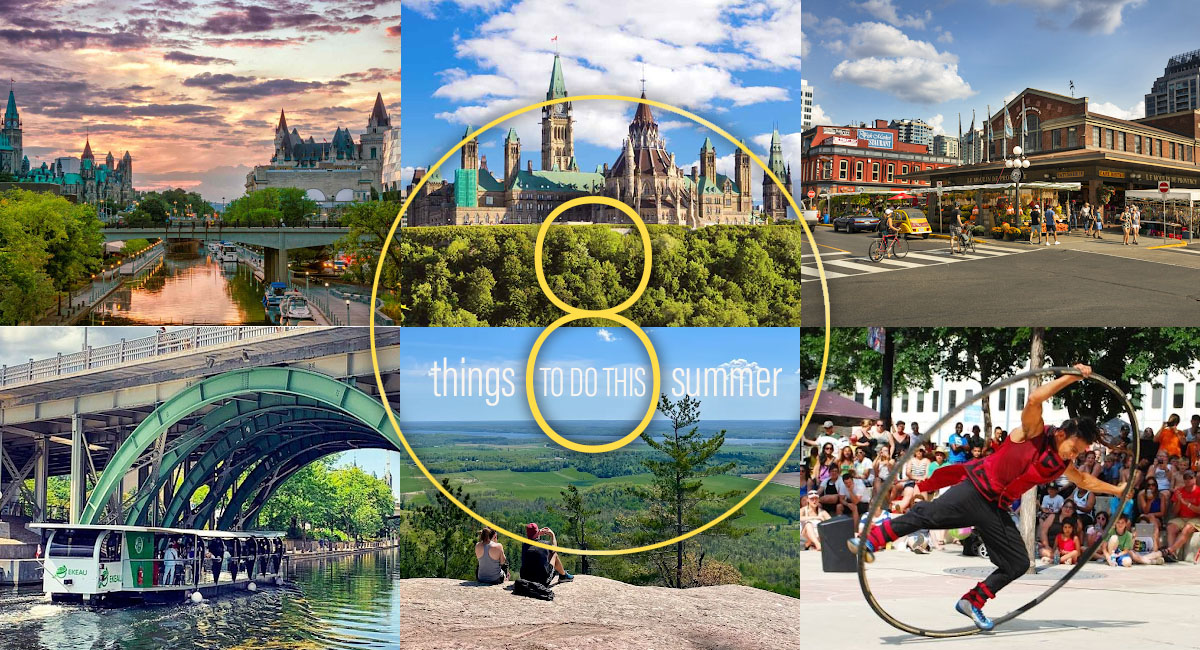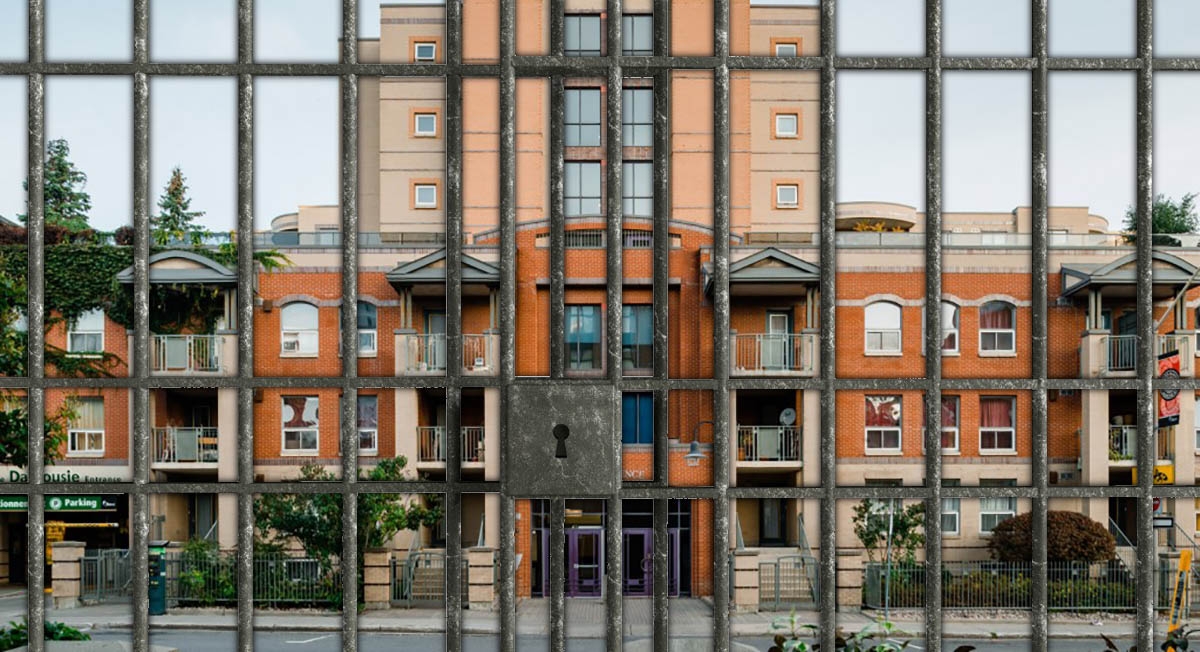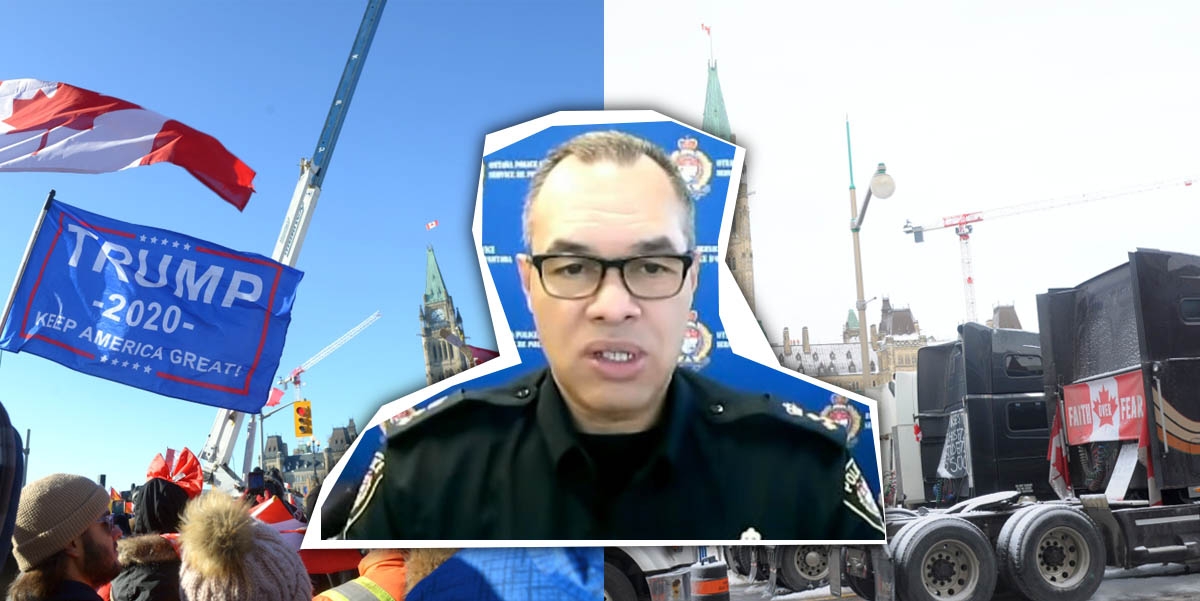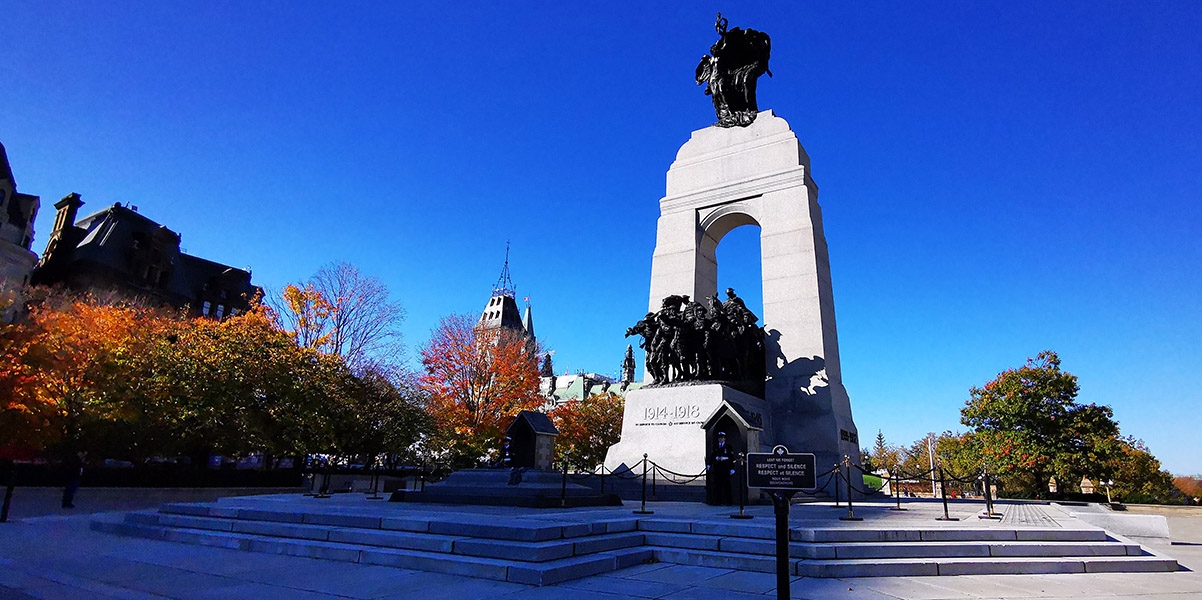
Reflect and give thanks: memorials and sites to visit on Remembrance Day
The Cartier Square Drill Hall adjacent to City Hall was humming with activity last Saturday morning as army cadets resplendent in their dark green uniforms and polished boots came and went with their boxes of poppies, and a children’s choir practiced their performance for a Remembrance Day service. In a capital city dotted with military monuments dedicated to the dead, wounded and those who served, it was a cue that remembrance lives not only in stone edifices and the bronze of statues but within each of us. As we approach November 11th, the nation’s eyes will focus on the National War Memorial, with its soaring arch and 22 bronze figures of “The Response”. The Tomb of the Unknown Soldier lies at the foot of the Memorial, soon to be covered with poppies. The Valiants – a series of statues and busts commemorating important military figures in Canadian history dating back to the British French conflicts of the 18th Century – stand guard just steps away. The statue of General Sir Arthur Currie, Commander of our World War 1 forces, is decorated with a poppy.
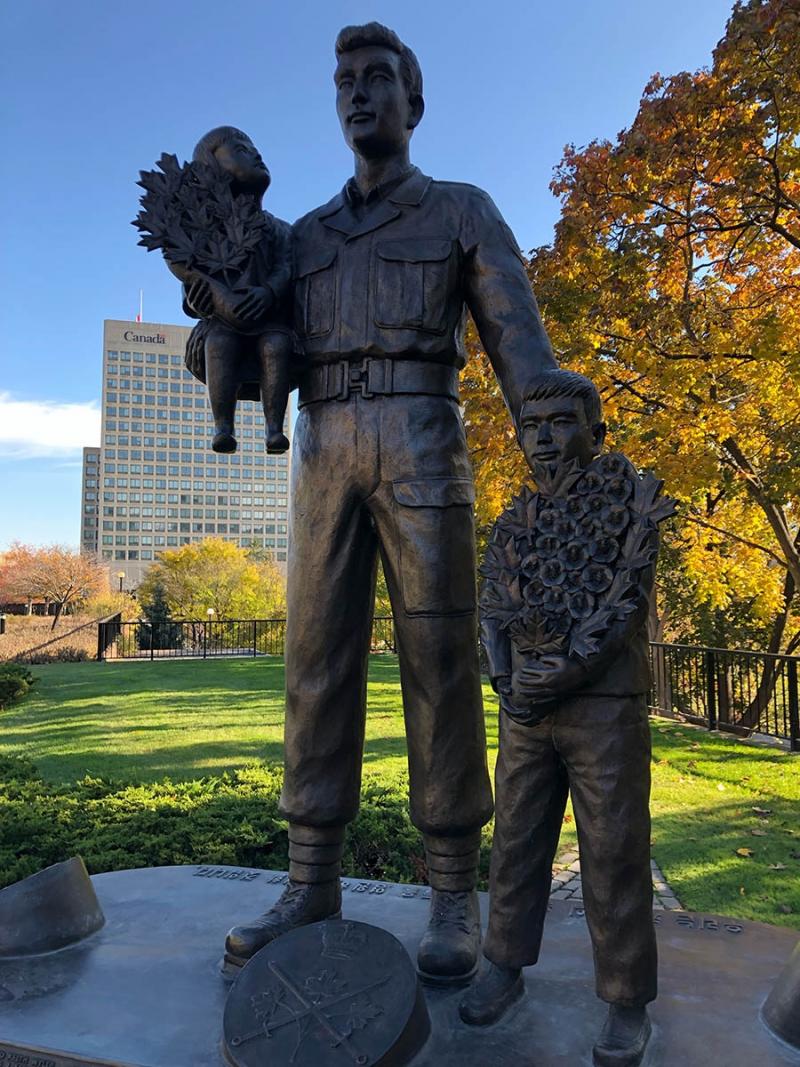
ABOVE: Look for the Korean War Monument on the Mackenzie King Bridge across from the NAC.
On November 11th or anytime for that matter, the city has many other monuments and sites that may be visited for a moment of reflection and thanks. Some are surprisingly well-hidden or speak to conflicts Canadians may not be aware of, that have faded in the mists of time. In the forecourt of the Drill Hall stands a statue to two young Ottawa natives killed at the battle of Cut Knife Hill during the Northwest Rebellion in May of 1885. Crossing Laurier Avenue to Confederation Park stands the impressive National Aboriginal Veterans Monument, topped by an eagle-in-flight. The people of Poland have erected a monument to Canadian airmen who died in action over their country during WW2, primarily in support of the liberation of Warsaw from Nazi occupation in the late summer of 1944. Two statues stand on the opposite side of the fountain; a monument to Ottawa soldiers killed in the Boer War in what is now South Africa at the turn of the 20th Century, and the child-friendly Animals in War Dedication. Three bronze plaques highlight the role that mules, horses, dogs, and carrier pigeons played in wartime. The dog, cast in bronze includes a medical backpack such as would have been carried in WW1. As I happened along, a youngster was enthusiastically petting the dog, bringing concepts of war and sacrifice to a level a child could easily understand.
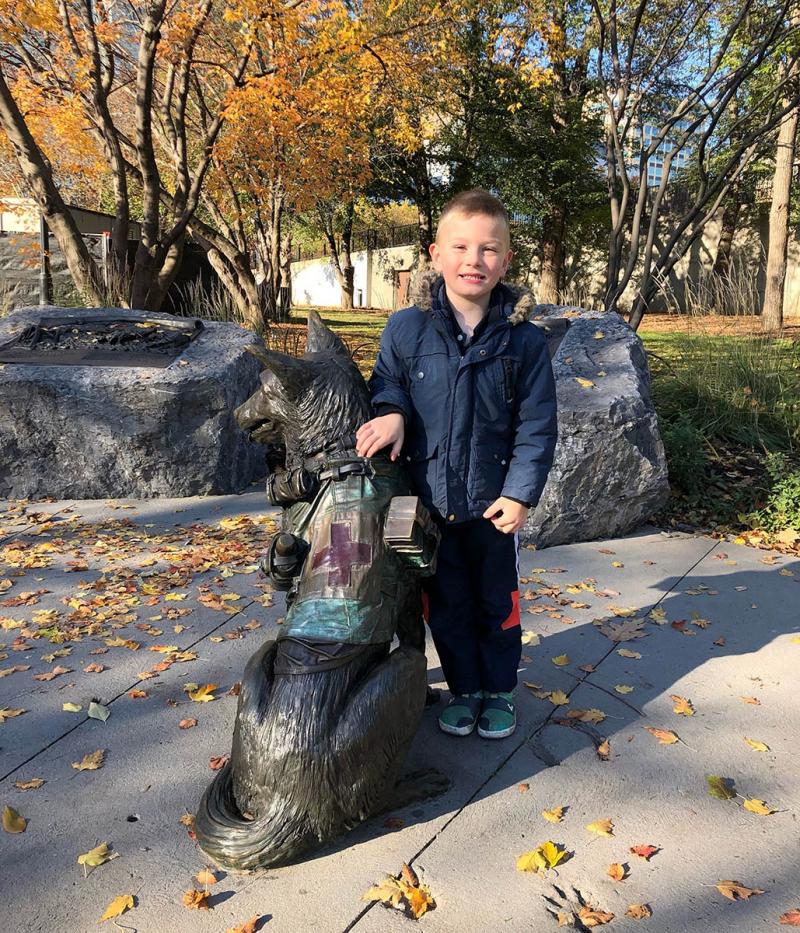
ABOVE: The Animals in War Dedication in Confederation Park.
Mounting the stairs to the Mackenzie King Bridge, is the Korean War Monument. More than 30,000 Canadians served in the Korean War from 1950-53, and 516 gave their lives in the cause of freedom. Framed by the yellow and red trees of the park below, the monument shows a Canadian soldier holding two Korean children. Below the inscription, “We will never forget you brave sons of Canada”, are the names of the fallen. A beautiful monument but it faces the blank south facing façade of the NAC, with buses and cars rumbling by, and unless one is walking, it is likely rarely noticed.
Further west along the Parkway is the Canadian War Museum. Situated appropriately at 1 Vimy Place, the museum is in equal measure, an educational facility, a repository of documents, and equipment central to our military history and a place of remembrance. A chamber within the museum contains the tombstone of Canada’s Unknown Soldier, “Known Unto God” – taken from a cemetery near Vimy Ridge. On the 11th hour of November 11th, a beam of light from an overhead window shines directly on the tombstone. Visitors can see this effect daily though the time changes with the seasons. The National Holocaust Memorial sits opposite on Booth Street in memory of the six million Jews killed by the Nazis and their evil collaborators. Visitors enter the structure in the shape of the Star of David and descend into a central space with ‘photographic landscapes’ of the Holocaust painted on the walls. Other interpretative panels explain the contributions of Holocaust survivors and their descendants to Canada.
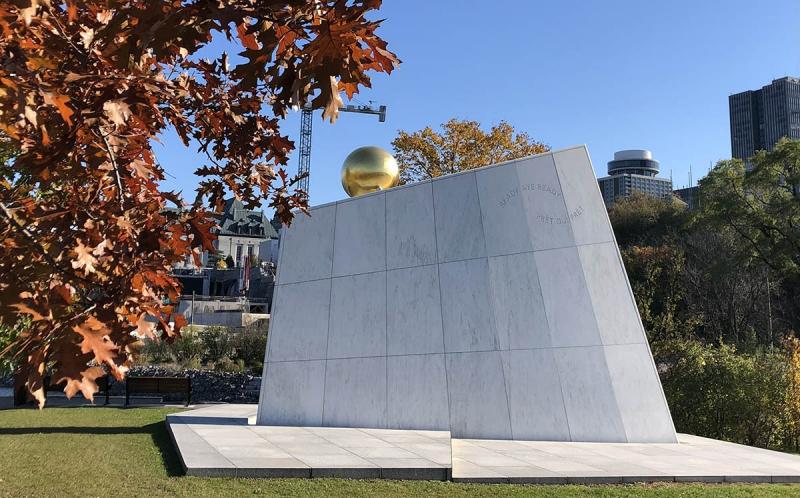
ABOVE: The Royal Canadian Navy Monument stands on Richmond Landing, in the heart of Ottawa.
The gleaming white marble of the Royal Canadian Navy Monument graces the tip of a peaceful promontory in the Ottawa River, accessible from the paths leading from the Portage Bridge. Impressive views beckon to Parliament Hill and beyond to the spires of Notre-Dame Basilica. The monument effects the prow of a ship and includes the dates of naval engagements with the names of every ship and naval establishment. There have been four ships christened “Ottawa”, with two each of Grizzly, Raccoon and Reindeer.

ABOVE: Reconciliation pays tribute to Canada’s peacekeepers who have served in numerous multinational operations around the world.
Reconciliation, the Peacekeeping Monument situated between the National Gallery and the ByWard Market, commemorates Canadians who have served on overseas missions primarily as part of United Nations forces and the 130 who have died in this service. Three bronze figures positioned at the end of a rubble-strewn walkway give effect to the words of Nobel Peace prize winner and future Prime Minister Lester B. Pearson, who said in 1956, “We need action not only to end the fighting but to make peace…”.
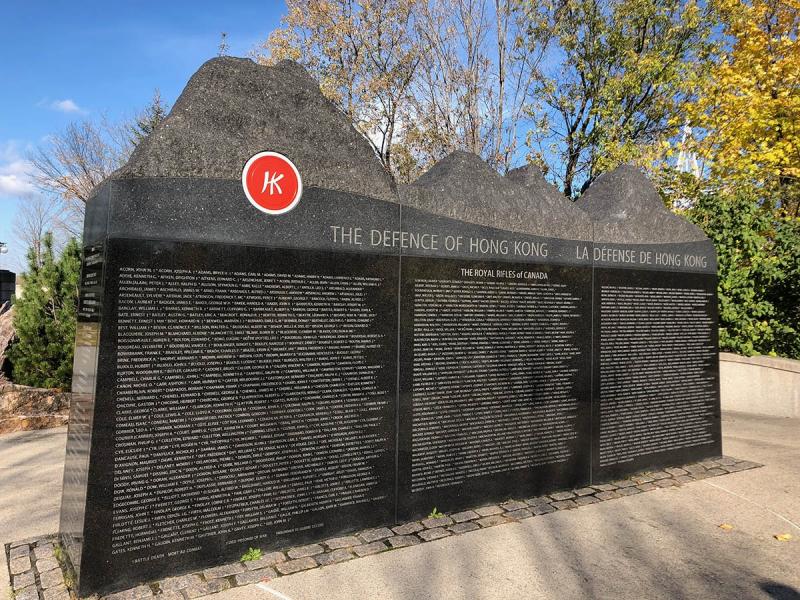
ABOVE: The Defence of Hong Kong Memorial Wall.
Further down Sussex Drive at King Edward is the beautiful Defence of Hong Kong Memorial Wall. During Canada’s first land battle of WW2 in December 1941, 1,975 men and two women, held off a much larger Japanese invading force for 17 days. Nearly 300 were killed in action with another 267 dying in Japanese prisoner of war camps, subjected to starvation, torture and diseases. Clad in black granite, the monument is topped by concrete peaks, evocative of the Kowloon Mountains that frame Hong Kong. The names of those that fought are etched in the granite, with notation for those who died in battle and imprisonment. A block away, near-hidden by fencing and trees along the Rideau River is the CANLOAN Memorial – dedicated to the hundreds of Canadian officers who volunteered to serve in the British Army, 128 of whom died in the battles between D-Day and Germany’s surrender in May 1945.
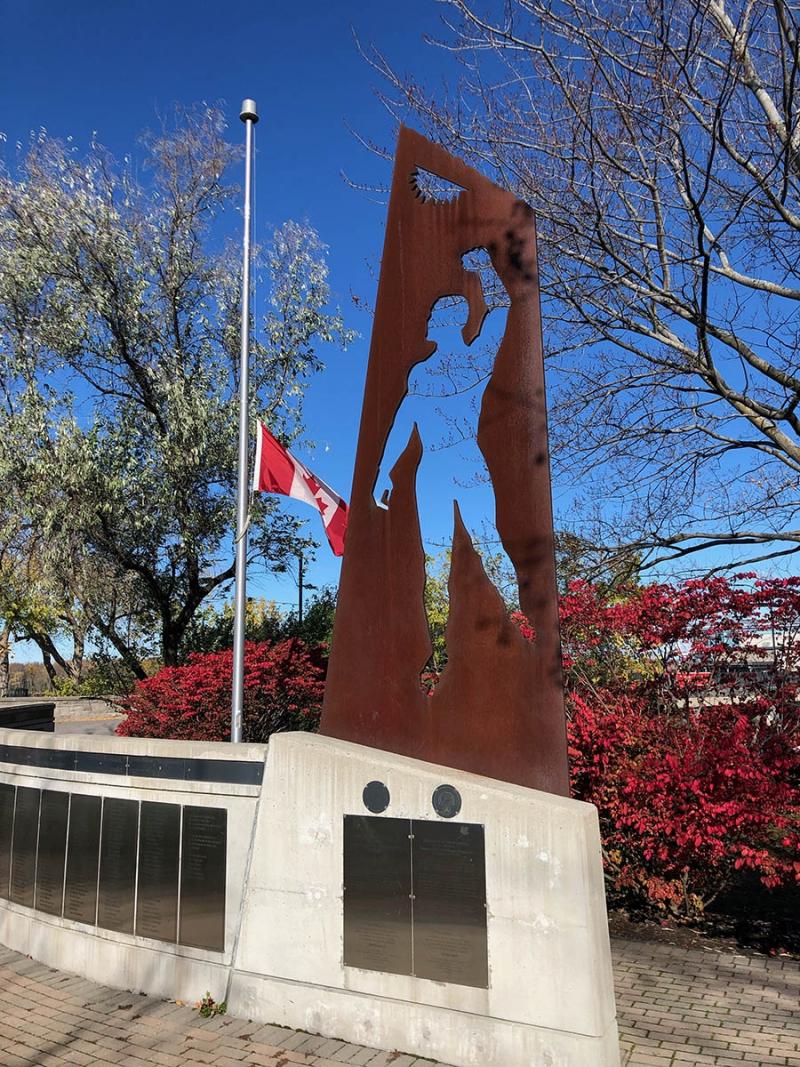
ABOVE: The Mackenzie-Papineau Battalion monument features the silhouette of a young man, described as a “Promethean” figure, raising a clenched fist toward a Spanish sun.
Crossing Sussex Drive brings one to three distinctive monuments in Rideau Falls Park. One honours Canadians who fought and died as members of Mackenzie-Papineau Battalion in the Spanish Civil War. Predating WW2 by a few years, this conflict between the Nationalists (fascists) and the Republicans has been posited by some historians as the opening salvos of the war that would erupt in 1939. Canadians fought as members of the pro-Republican International Brigade. With the Ottawa River as a backdrop, a large globe seemingly held aloft by an eagle commemorates the 800 men and women who died serving in the air forces of the Commonwealth from bases in Canada, the United States, and the British West Indies.
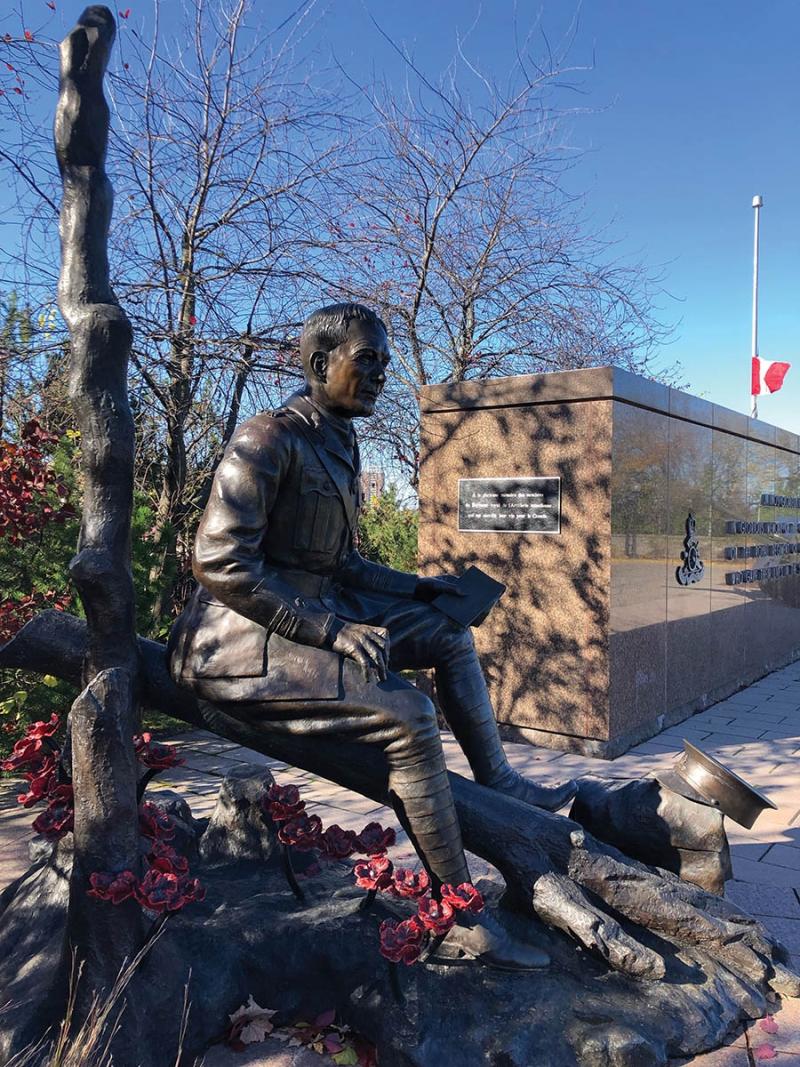
ABOVE: The statue of WWI doctor Major John McCrae was unveiled near the National Artillery Memorial exactly 100 years after he penned his famous poem.
The third is a monument to the Royal Artillery of Canada and the contribution of bombardiers over the course of the last century and a half. Most poignant for Remembrance Day is a statue of Major John McCrae – a doctor appointed to the artillery – and the author of “In Flanders Fields”. Seated beneath a shell-shattered tree, Major McCrae stares into the distance with notepad in hand. The poem was written at the Ypres front in May 1915, within hours of the death of Alexis Helmer, McCrae’s best friend and fellow McGill medical graduate. Aside from O’Canada, is there any other secular writing that Canadians of all ages can recite from memory? Simultaneously haunting and uplifting, its verses motivated the selection of the poppy as the symbol of remembrance. McCrae would survive the carnage of the front and be promoted to Colonel but tragically, died of pneumonia in 1918.
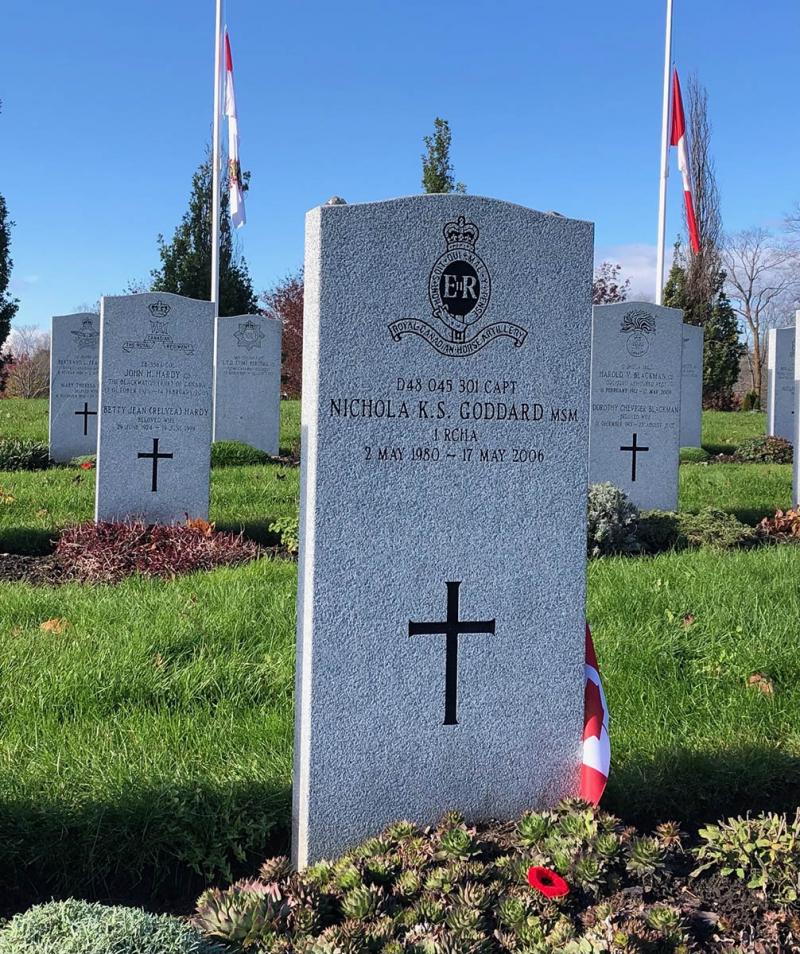
ABOVE: The tombstone of Captain Nichola Goddard stands solemnly in the National Military Cemetery of the Canadian Forces, at Beechwood Cemetery.
The early morning dew was heavy on the grass as I walked among the tombstones ‘row on row’ in the National Military Cemetery, which is located within Beechwood Cemetery. Established in 2007, these grounds of remembrance include those servicemen and women who died in the line of duty or wished to be laid to rest among their comrades. Within minutes, I found the graves of Corporal Robbie Beerenfenger and Captain Nichola Goddard, who were killed in action in Afghanistan in 2003 and 2006, respectively. Born in Ottawa in 1974, Cpl. Beerenfenger was among the first Canadians to be killed in action with the enemy, and Captain Goddard was the first female Canadian soldier to be killed in action there. Her death inspired the song “Highway of Heroes” by The Trews. As the song goes, their “true patriot love was never more true”.
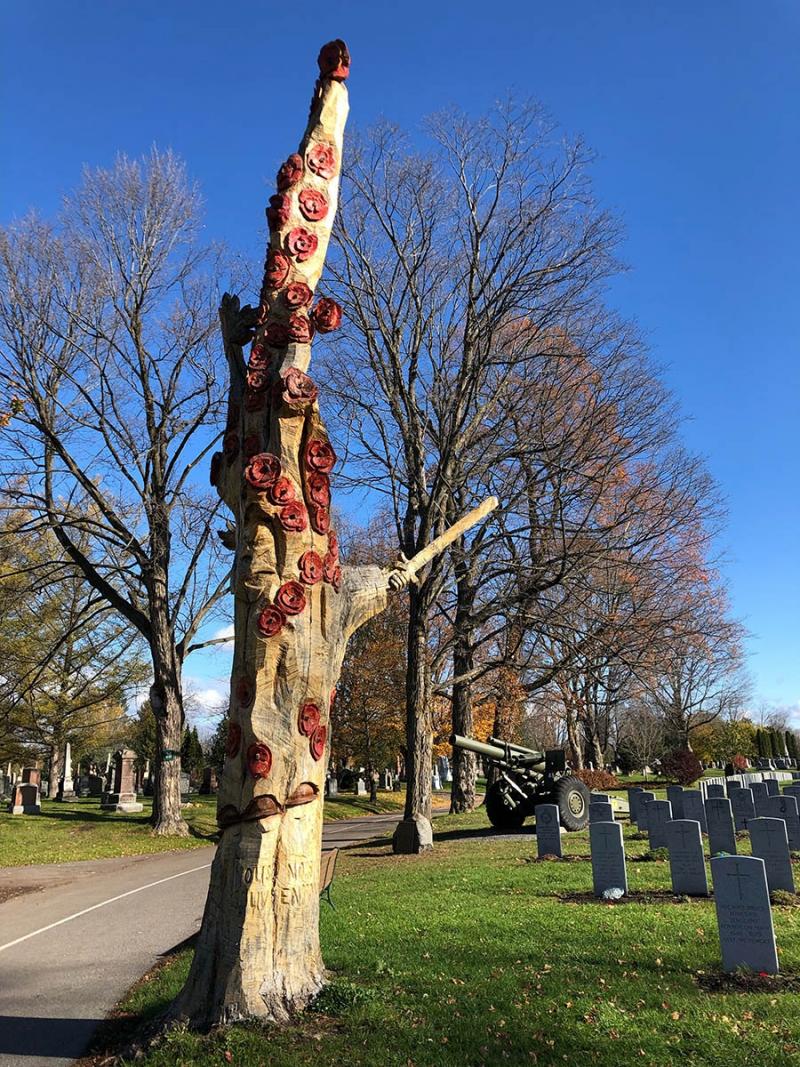
ABOVE: Beechwood Cemetery holds an annual Remembrance Day ceremony and offers guided tours on the fourth Sunday of each month.
The older section (Section 27) is down a slight treed incline with a field of headstones radiating out from a large white Cross of Sacrifice. A World War 2-era Sherman tank and artillery pieces flank the evenly spaced headstones, each decorated with a poppy. The splash of red stands out against the green ground cover and yellow maple leaves that have fallen. Nearby, a gnarled tree has been carved with poppies and helmets, painted to stand out. A broken branch has been carved into a sword and another into a clutch of maple leaves.
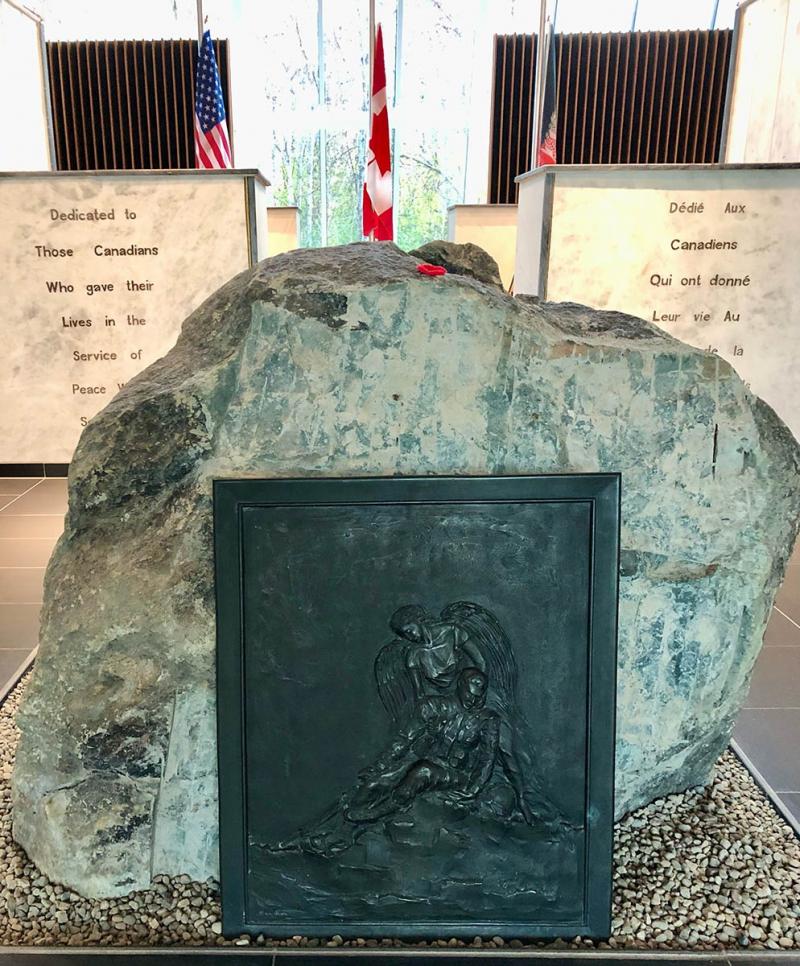
ABOVE: A rock taken from the site of the first Canadian combat deaths in Afghanistan is part of the Cenotaph at DND headquarters on Moodie Drive.
The Afghanistan Memorial Hall located at the Moodie Drive National Defence headquarters is Ottawa’s newest and, perhaps, most moving tribute to Canada’s fallen warriors. The Kandahar Cenotaph was brought home as the Canadian mission ended in 2011. The Cenotaph includes a large rock, taken from the site of the first combat deaths in that mission; road mines that killed Cpl. Beerenfenger and Sergeant Robert Short of Fredericton. A bronze relief of an angel holding a fallen soldier graces this battlefield monument. The Taliban had placed this rock on a dusty road to steer traffic over the mines. Plaques honouring the fallen were affixed to this rock but as the war took its grim toll, two marble towers were built for the ever-increasing number of plaques. DND calls this Cenotaph a “grassroots endeavour by soldiers” and all the original materials were sourced near Kandahar. The names and faces on the plaques are not as John McDermott sings in the Green Fields of France “faded to yellow in a brown leather frame”. We know these young faces from news reports and the sad processions along the 401 ‘Highway of Heroes’. A national monument will be constructed along the river opposite the War Museum by 2024.
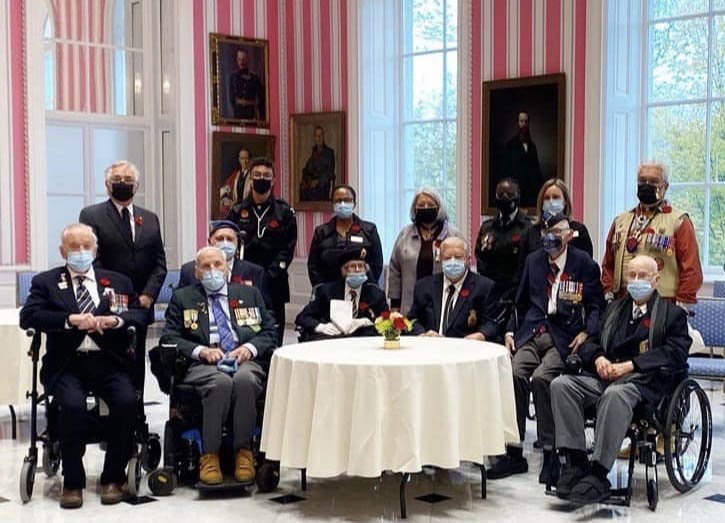
ABOVE: Mr. James Hayes (front row, far right) at Rideau Hall with fellow veterans and Her Excellency Mary Simon, Governor General, October 2021. (PHOTO: Royal Canadian Legion)
“They shall not grow old, as we that are left grow old; … We will remember them.” Ultimately though, the vessel of remembrance lies not just in stone and bronze but in each of us; those who served and sacrificed and others like the children practicing their songs. I was reminded of this on the weekend as I heard the sad news of the death of a friend’s father, a Royal Canadian Air Force veteran just one month shy of his 100th birthday. James (Jim) Hayes of Ottawa, was among the group of veterans who presented the first poppy to Her Excellency Governor General Mary Simon at Rideau Hall less than a month ago. Mr. Hayes served his country, grew old, but now, he too belongs to the ages. Lest we forget.
PHOTOS: All photos, except the image of Mr. James Hayes at Rideau Hall, by Dan McCarthy.

